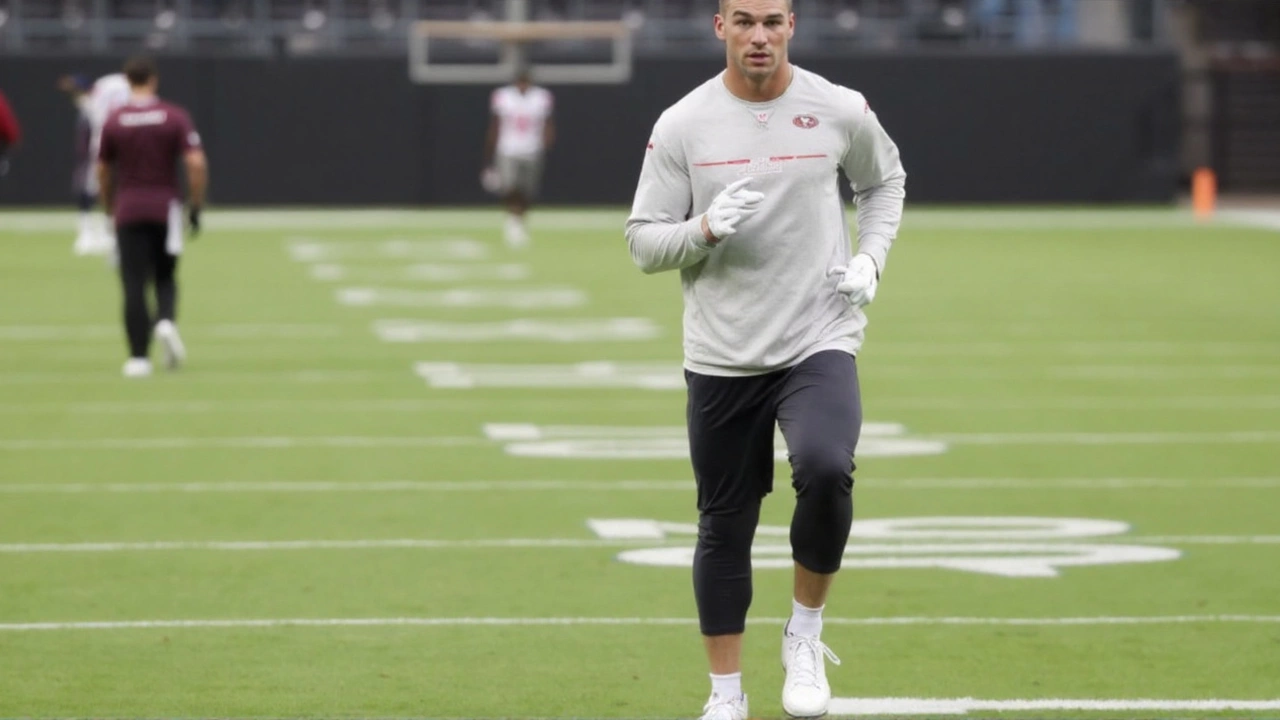Week 1 always throws the first punch before kickoff. Two headliners—Christian McCaffrey and Micah Parsons—are shaping up as game-time decisions, and that puts millions of fantasy lineups on thin ice. If you play in a league with tight benches or late-afternoon kickoffs, your Sunday just turned into a juggling act. This is where titles are won: with a cool head, a working plan, and a quick thumb when inactives drop.
Fantasy football managers are also tracking a cluster of wide receiver issues, led by a high-ankle recovery for Khalil Shakir, a Week 1 absence for Chris Godwin despite PUP activation, and a tricky Jones fracture comeback for Jayden Reed. Add in ripple effects along offensive lines (Detroit’s Taylor Decker didn’t practice but carries no tag) and depth-chart shakeups (Carolina’s Jalen Coker out, rookie McMillan elevated), and you’ve got a slate begging for sharp pivots and matchup plays.
The headliners: McCaffrey and Parsons on the brink
Christian McCaffrey’s status is the biggest domino on the board. He’s not guaranteed to go in the opener, and if he dresses, a snap limit wouldn’t be shocking. That uncertainty should shape your roster now—not 10 minutes before kickoff. If he’s a late window decision, move him into your flex to widen your swap options, and make sure you’ve got late-game replacements stashed on your bench. If your league allows same-day adds, earmark a couple of backfield safety nets from late games so you’re not trapped.
What’s the projection if McCaffrey sits? Expect split usage behind him, which is bad news for clean fantasy value. Commit to either safe touches (short-area backs with receiving roles) or pure upside (goal-line vultures who can score without volume). If you’re projected to lose, lean into touchdown volatility. If you’re favored, chase secure workloads and floor.
Micah Parsons is a different kind of headache. He’s been dealing with a back issue for weeks and stayed limited in practice, leaving his Week 1 fate to a pregame test for the Green Bay Packers. IDP managers know the drill: back injuries can sap explosion and bend, which is everything for a premier edge. If he’s active, there’s still risk he rotates more than usual. If he’s out, downgrade Green Bay’s pass-rush ceiling and slightly upgrade the opposing quarterback’s pocket comfort. For streaming team defenses, this is enough to break ties elsewhere.
Action plan for the big two:
- Park any true game-time calls in your flex if their game kicks later. That keeps RB/WR/TE options open.
- Build a two-player pivot: one safe-floor option from the early slate and a late-slate upside play. Decide which you’ll use based on your Sunday noon projection.
- If you roster McCaffrey, prioritize touchdown access with your other flex spots to smooth out the volatility.
- IDP managers: pre-identify a comparable snap-secure linebacker or edge rusher with a noon kickoff in case Parsons sits.
Wideout triage, ripple effects, and start/sit calls
Khalil Shakir is trending toward active after an early-August high-ankle sprain. Those injuries hurt burst and lateral cuts for weeks, even when the player is cleared. Buffalo draws a rugged Ravens defense, and that’s not the matchup to test compromised explosiveness. If you have a bankable WR3 on your bench, use him and keep Shakir as an emergency PPR patch. If you start Shakir, you’re betting on schemed touches and red-zone creativity, not separation and yards after catch.
Chris Godwin won’t go in Week 1, even after coming off the PUP list. Tampa Bay is choosing the long game, ramping him up with conditioning before he returns later this month. In fantasy terms, that opens targets in the short and intermediate areas. Expect the Buccaneers to distribute slot-heavy work among role receivers, tight ends, and backs. If you were counting on Godwin as a weekly WR2, consider a two-week patch plan now—don’t burn FAAB in panic on a one-week gadget play.
Jayden Reed is expected to suit up for Green Bay, but the context matters—he’s coming off a Jones fracture, a foot injury that can sap explosiveness and complicate sharp route breaks. Even if he’s active, a pitch count or limited snap types wouldn’t shock anyone. Fantasy analysts have already flagged the risk and suggest a sit in standard formats. The silver lining: it pushes opportunity toward Matthew Golden, who could see a bump in targets and red-zone looks if Reed’s workload is curtailed.
Two under-the-radar situations carry real weight for context. Detroit’s left tackle Taylor Decker didn’t practice all week but carries no official injury designation. That’s odd on paper, but it likely points to veteran maintenance and pain management. For fantasy, it’s a small yellow flag on pass protection and outside-developing routes. Not a downgrade you overreact to—just a reminder to favor quick-game receivers and backs if you were breaking ties. Meanwhile, Carolina’s Jalen Coker is sidelined with a quad, which nudges rookie McMillan into the No. 1 role. Volume is king, but rookie WR1 roles on rebuilding offenses can be high on targets and low on efficiency. In deeper leagues, McMillan is a viable flex if you need raw looks; in shallow formats, he’s a bench stash you evaluate after you see the usage.
Matchup hunters circled one line in red ink: DJ Moore and Rome Odunze versus Minnesota. The Vikings allowed the second-most receiving yards and the most fantasy points to outside receivers last season. That’s not a subtle trend. If you were wavering on Moore as a WR1/2 in Week 1, stop wavering. Odunze gets a clear nod as a high-upside WR3 with splash-play potential. This is the kind of spot where one deep shot can swing a matchup.
Start/sit quick hits for Week 1 injuries and their fallout:
- Safer starts: Receivers with stable roles in condensed passing trees, especially in games with neutral weather and no travel funk. Think chain-movers who carry a six-to-eight target baseline if your lineup already has volatility.
- Cautious starts: Any wideout coming off an ankle or foot injury facing press corners or heavy pattern-match coverage. Those routes demand suddenness.
- Upside darts: Matthew Golden if Reed is limited; rookie McMillan with Coker out; secondary slot options in Tampa Bay while Godwin ramps.
- Floor plays: Backs with pass-catching roles on teams missing a primary receiver—checkdown volume often spikes in those scripts.
How to play the inactives window like a pro:
- Set two provisional lineups Saturday night: one assuming McCaffrey plays, one assuming he sits. Do the same for Parsons if you’re in IDP.
- Put any questionable player in your flex. It’s basic, but it’s the difference between a W and a bench tantrum.
- Map your time slots. If your risky player is in a late game, roster at least two late-slate pivots with usable roles.
- Watch beat reports for “snap count” or “packages only” language. That’s a red flag for low-ceiling starts.
- If projected to lose by 10+ entering late games, flip conservative floor options to boom-or-bust profiles.
What’s the risk profile for these injuries?
- High-ankle sprain (Shakir): Often lingers. First game back typically shows reduced burst and tackle-breaking. Expect more sideline routes and schemed touches than dynamic YAC.
- Jones fracture (Reed): Pivoting and late-snap violence can be limited early. Recurrence risk exists if usage spikes too fast. Coaches often throttle reps in Week 1.
- Back management (Parsons): Power-to-bend transfer is everything for rushers. Even if active, in-game flare-ups can cut a series or two off a pass-rush rotation.
- Soft-tissue ramp-ups (Godwin): Teams get conservative in September. You’ll often see conditioning checkpoints before full routes come back.
Deeper league notes and speculative adds:
- Matthew Golden: Arrow up if Reed is active-but-limited. He profiles as a contingency chain-mover who can also earn red-zone looks. In 12- to 14-team leagues, he’s a top bench add.
- Rookie McMillan (Carolina): Volume magnet by necessity with Coker out. Don’t expect pristine efficiency, but 7–9 targets are on the table in negative game scripts.
- Tampa Bay auxiliary targets: With Godwin out, keep an eye on who soaks up slot routes early. If one player grabs a 20-plus percent target share, that’s instant flex value until Godwin returns.
- Detroit pass protection: If Decker’s snap quality dips, prioritize quick-hitting slot and tight end routes over slow-developing perimeter shots when setting tiebreakers.
If you’re building DFS or setting a risky redraft lineup, lean into the Vikings matchup data. Minnesota leaked explosive plays to outside receivers last season, and that dovetails with Moore’s downfield skill set and Odunze’s size-speed profile. In small-field DFS, you can pair one of them with a bring-back from Minnesota’s side to capture a game environment. In redraft, elevate them a tier inside your ranks for Week 1 only.
And remember, the first week is noisy. Conditioning varies, coaches script first 15 plays like it’s a lab, and defenses throw unscouted looks. That’s why your process matters more than a single projection. Protect your floor with sane roles, then pick your spots for aggression where the matchup screams for it—like Moore and Odunze versus Minnesota—and where injuries open doors—like Golden and McMillan if their usage pops right away.
Sunday checklist before kickoff:
- Scan the final practice notes one last time. Limited all week usually means a true test at warmups; full Friday often signals “good to go.”
- Confirm inactives 90 minutes before each kickoff. Don’t assume. Click the update.
- Be ready to late-swap. Keep one bench spot free for a same-day pivot if your platform allows.
- Track the first series for injured-but-active players. If a guy is clearly decoying, adjust expectations in DFS or late-slate contests.
Week 1 won’t wait. McCaffrey and Parsons will make or break matchups before many managers even have lunch. Shakir, Godwin, Reed, Decker, and Coker have already nudged schemes and target trees in subtle ways. If you’ve prepped your pivots and mapped your time slots, you’re playing from ahead—no matter what the questionable tags say at 11:29 a.m.

